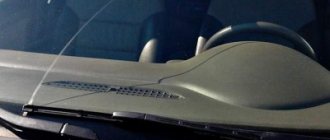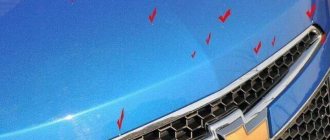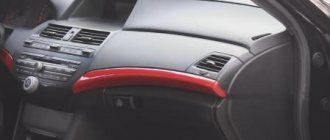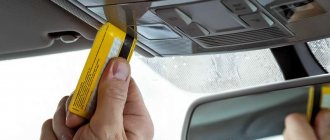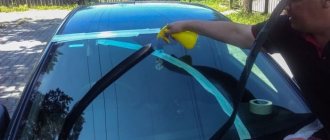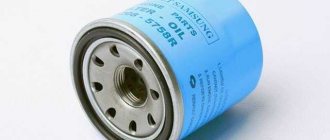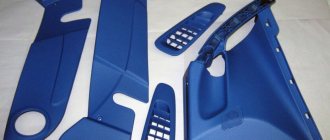Low quality plastic, constant entry and exit from the cabin, “flight” of keys and other personal items - all this causes scratches in the vehicle interior. On the one hand, it is impossible to avoid the appearance of these defects, so many do not pay attention to them. But on the other hand, they spoil the appearance of the interior and make it uncomfortable.
Therefore, it is best to get rid of scratches as quickly as possible. However, the following question remains relevant: how to remove scratches on plastic in the car interior with your own hands?
Time-tested methods
If there are shallow damages on the surface of the plastic, they can be removed using:
- anti-scratch products;
- polishes;
- special pastes;
- pencils that eliminate defects;
- improvised means (lighter, hair dryer, rags).
If you use at least one of the methods mentioned above, you can guarantee a high chance of success. Not confident in your abilities? Then, most likely, you cannot do without the help of specialists.
Lighter
Before you removed scratches from the plastic inside your car, you most likely didn’t even suspect that this could be done with an ordinary lighter. But practice shows that this is quite possible to do.
It is enough to buy not an ordinary gas lighter, but one that emits a blue flame. Briefly press the ignition button to slightly warm up the problem area.
The plastic will heat up and the scratches will smooth out evenly. It is highly recommended not to touch the surface with your fingers, as this can damage it.
Note! The presented method for removing a scratch from interior plastic is only suitable if the defect is on smooth plastic. If they are present on a part with a “bumpy” structure, it is quite possible that the entire texture will be distorted. Accordingly, the appearance of the plastic will greatly deteriorate.
Polishes and gels
The second way to get rid of scratches on interior plastic once and for all is to get a special polish. Their application is quite simple. You just need to apply the restoration cream to the plastic and wait for it to completely harden.
At the moment, the most popular materials are “Displex” and “Disc Repair”.
Their microparticles are able to interact with the plastic surface, as a result of which the paste completely clogs problem areas. Optical distortions in places where the scratch is refracted are completely removed. Accordingly, defects are no longer visible.
Attention! The procedure for applying Displex paste is simple even for beginners. In order to rub the composition over the surface, you must use a cotton cloth or a cotton swab. Never apply the paste with your hands! Complete drying time is from 20 to 40 minutes, depending on temperature conditions, depth/size of the scratch and air humidity.
How to properly remove scratches from gloss?
The question of how to remove scratches from glossy plastic is most often of interest to owners of foreign cars. Large defects are quite difficult to eliminate on your own, but if you do everything as described below, there will be no problems.
- Apply a special composition to the damaged area. “Displex”, described above, is suitable, but it all depends on the properties and type of plastic.
- Sand the damage. Do the procedure carefully.
- Once the composition has hardened, apply a textured pattern to the surface of the plastic. To do this, a special fixative gel is used. It is applied to the undamaged part. As soon as the gel hardens, the design is transferred to the place that needs restoration.
- Tint and paint the area to be restored.
We recommend: Do-it-yourself replacement of the pump on a VAZ 2107
There is also a polish for the dashboard “Atas Plak” (750 ml bottle). The product contains silicone, which adds shine and protects the interior from dust.
According to reviews, it works well to remove scratches from glossy plastic. You can buy it, try it out and leave your feedback in the comments.
Restorative pencils and towels
Those who are wondering how to remove scratches on plastic in a car can use special wax pencils or crayons of a suitable color. They are sold at any car store.
HardWAX wax pencils
Thanks to the contents of the pencil, the material will completely fill the damaged part, leveling all defective areas. Once the product has completely hardened, you can begin polishing and applying paint.
The presented method is the most popular, since at home it allows you to get rid of damage as quickly as possible. The surface is usually painted if the color of the marker does not match the shade of the plastic. But if you can match the tone exactly one to one, you won’t have to do any coloring.
Remember! Regardless of what product you use or how deep the scratches are on the surface, always degrease the surface. The most optimal degreasers are acetone and alcohol. Never use gasoline or white spirit! The substances that are in their composition are able to penetrate deep into the material, making it very fragile. Aggressive substances can completely damage the surface of the plastic.
Wiping towels. Try rubbing out scratches using professional rags that can be found on sale.
Before removing scratches from transparent plastic, be sure to degrease the surface. Depending on what kind of material needs to be processed (matte, glossy or transparent plastic), use different materials and techniques.
The easiest option is to heat the surface with a lighter that emits a blue flame. If the nature of the damage does not allow you to use this method, you will have to pick up a cream paste or a restorative marker. Having performed the procedure correctly, after the materials have completely hardened, it will become impossible to find the place where the scratch was.
In any case, if you feel that you cannot get rid of such interior defects on your own, it would be best to seek the help of service center specialists. Full-time employees, using highly specialized tools and special equipment, will restore the interior as quickly as possible.
Removing scratches with wiping towels
Ways to eliminate flaws:
- Lighter.
- Construction hairdryer.
- Wax pencils.
- Polishing.
- The overhaul is carried out in a professional workshop, the plastic is cleaned, primed, painted, and varnished.
External defects can be removed using a lighter; turbocharged products with high temperatures and stable combustion are best suited. The problem area is heating up, you can’t keep the fire in one area, the hand with the lighter is constantly moving.
The flame is not brought too close; a suitable distance is selected so that the part does not melt. The abrasions will heal slowly; in a heated area, the soft plastic should not be touched with your hands. This method is suitable for smooth plastic; the structure of the corrugated surface changes after heating. Instead of a lighter, you can use a hair dryer that generates high heat. Sometimes the power of the device is enough to dry your hair. Before use, remove dirt, dust, and allow automotive cleaning chemicals or dishwashing detergent.
The hair dryer is turned on at a low temperature; if deformation does not occur, the power increases. Small damages are reduced immediately and polished for a better appearance. Microfiber cleaning towels are sometimes used. This is an effective method, the problem area is actively rubbed, all minor defects are eliminated. Dirty rags are washed and reused many times.
Minor defects appear on the panels inside the machine. If they are not restored in time, abrasions will appear everywhere, creating a cobweb that will be more difficult to deal with. You have to go to a workshop; it’s difficult to get rid of the problem on your own.
Rating of popular polishes for plastic
The most common and logical question that arises among car enthusiasts looking for a polish is what is the best polish for plastic? There is no definite answer to this, since on the Internet you can find many conflicting reviews on the use of even the same products. Another factor is that the market is changing, new, more advanced polishes appear in stores, and old products are discontinued.
The following is a rating of popular plastic polishes. It is not commercial in nature and does not intend to advertise any product. The list is compiled based on tests and reviews from car owners who have used the compounds listed below at different times. We hope the information provided will help you make your choice and buy a plastic polish that meets your expectations.
Fast acting plastic polish Turtle Wax
TURTLE WAX GL DRY TOUCH polish shows the highest efficiency in polishing plastic surfaces in the car interior. After treatment with this product, the plastic receives a rich color, and small scratches become invisible. The polish can also be used on rubber and leather surfaces. The composition dries quickly thanks to the “dry shine” formula. Also, turtle wax plastic polish can be used for external car parts made of this material and rubber seals.
Before use, shake the bottle well and then apply the product to the surface to be treated. Allow the polish to soak in for one to two minutes. Next, use a dry cloth to thoroughly polish the surface. If the plastic is heavily soiled, it must first be cleaned with appropriate compounds. The manufacturer does not recommend using the “turtle” on the steering wheel, since the product creates a slippery layer.
Sold in a 300 ml bottle with a push-button sprayer. Its article number is FG7622. The price as of summer 2018 is about 450 rubles.
1
- Pros:
- masks minor scratches;
- instant drying;
- no greasy shine;
- wide range of applications;
- Minuses:
- relatively high price;
- forms a sliding layer;
Effective foam polish for plastic elements HI-GEAR
According to numerous reviews from motorists, polishing the dashboard and other plastic elements of the car interior is very effective. The manufacturer positions it as a “3 in 1” product that provides cleaning, shine and protection of the treated surface. It is a foam polish. Can also be used on rubber and vinyl surfaces. After polishing with a product from Haigir, a dense silicone protective layer is formed on the panel, which prevents possible scratches and protects the dashboard from exposure to ultraviolet radiation. Has a pleasant aroma.
The method of application is very simple. To do this, you need to apply a certain amount of polish to the previously cleaned surface. Wait a few minutes, then use a soft cloth or microfiber cloth to polish the surface until a characteristic shine appears. It is better to treat plastic elements in small areas so that the product does not dry out completely during the process.
Packaged in a 280 ml can. Product code: HG5615. The price of such a bottle for the specified period of time is about 450 rubles.
2
- Pros:
- protects against scratches;
- protection against sunburn;
- nice smell;
- Minuses:
- No;
Polish for adding deep color to the Runway interior
A good effective polish that leaves behind a deep, rich color. It is worth noting that Runway perfectly masks minor scratches on a damaged surface. It can be used not only for internal, but also external elements of the car body, for example, bumpers, moldings, turn signal glasses, and so on. The polish creates a reliable protective layer that protects the plastic from fading and cracking.
The application method is also different and similar to the previous product. That is, the product needs to be applied to a clean rag, and polished thoroughly using another rag (not fluffy). Please note that polish should not come into contact with skin or eyes.
, so it’s better to work with rubber gloves!
Packaged in 250 ml bottles. Product code: RW2539. The price of such a bottle is 250 rubles.
3
- Pros:
- masks scratches well;
- makes the colors of the treated surfaces more saturated;
- creates a protective layer against scratches and sun rays;
- Minuses:
- composition aggressive towards human skin;
- high consumption;
High-tech polish Nanox
The manufacturer positions Nanox as a miracle development based on “nanotechnology.” However, numerous tests of this polish have shown its mediocrity in performing the tasks assigned to it. That is, the efficiency is average. Nanox polish can also be used on rubber and vinyl surfaces. It has an antistatic effect that lasts quite a long time. It also effectively protects plastic from exposure to ultraviolet radiation.
The application method is similar. Using a hand sprayer, apply the product to the surface to be treated and then immediately polish it. Carry out the procedure until characteristic blackening appears.
Sold in 450 ml packaging with a manual sprayer. Product code - NX8344. It has a fairly high price - up to 600 rubles.
4
- Pros:
- antistatic effect;
- creates a protective layer from ultraviolet radiation;
- the effect of use is quite long-lasting;
- Minuses:
- not very high effectiveness of the drug;
Mattifying polish with a wide range of fragrances Sonax
A good popular Sonax polish with an apple scent. It not only polishes surfaces well, but also creates a protective layer on them. After treatment, a matte effect remains on the surface. Has antistatic and moisture-repellent properties. The product does not contain silicone. As for effectiveness, the reviews can judge its average degree.
The application method can be any - either using a cloth or directly spraying onto the surface to be treated. After this, using a dry rag or microfiber cloth, the product must be thoroughly rubbed into the part until a matte effect is formed.
Sold in a package with a 500 ml manual sprayer. The product code is 358241. Its price is about 300 rubles.
5
- Pros:
- antistatic agents in the composition;
- creates a protective moisture-repellent layer;
- after use it creates a mattifying effect;
- Minuses:
- mediocre efficiency;
Polish with an effective protective layer Lavr
Lavr plastic polish is positioned as a professional cleaning product for plastic, rubber and vinyl surfaces, including the dashboard. After application, it creates a good protective layer that prevents the harmful effects of ultraviolet radiation and minor mechanical damage. It has several types of flavors, including lime and cherry. However, many car owners note the average effectiveness of using this product. But there are also videos where resale bloggers use this product in the cars that they themselves sell. Whether this is an advertisement or a truly professional plastic polish, judge for yourself.
The application method is traditional. The main thing is to rub the polish using a clean rag so as not to damage the surface or leave marks on it.
Packaged in 400 ml cans. Its article number is Ln1625. The price of this product is 200 rubles, which is not bad for a fairly large bottle.
6
- Pros:
- forms a protective layer against sunlight and minor scratches;
- many different flavors;
- versatility (suitable for different surfaces);
- Minuses:
- low polishing efficiency;
Polish with lubricating effect Grass
The full name of the product is Grass Dashboard Cleaner. Positioned as a polish and dashboard cleaner. In addition to plastic, it can also be used with rubber, leather and wood. A distinctive feature of this polish is the fact that it can be used as a lubricant in small moving mechanisms. Eliminates unpleasant odors and fills the interior with its own aroma (there are several varieties). However, despite the high efficiency declared by the manufacturer, many car enthusiasts note that the product does not hide minor scratches well. Therefore, the decision to purchase it lies entirely with you, whether you succumb to the manufacturer’s promises or believe in real tests of using such a polish.
The application method is traditional. However, there is no need to wait time after applying the product to the surface. You can immediately afterwards rub the polish with a clean rag into the surface of the plastic or other part.
Sold in a bottle with a fairly large volume - 750 ml. Its article number is 1201071. The price of such a large package is only 300 rubles.
7
- Pros:
- can be used as a lubricant for small parts;
- fights foreign odors well, has different aromas;
- Minuses:
- does not mask scratches well;
DoctorWax restorative polish
A good plastic polish from Dr. Wax, which can also be used on rubber, leather and vinyl surfaces. Well restores the original appearance of plastic and masks scratches. This plastic restorer can be used on exterior car parts such as bumpers and moldings. Also has a cleansing effect. The protective layer created on the plastic prevents it from destruction and cracking due to the fact that the product contains protective vinyl. Removes foreign odors. Has an antistatic effect.
The product has an interesting drawback. After treating the dashboard with DoctorWax, after some time a white coating may appear on the inner surface of the windshield, which is quite difficult to wash off. The method of applying polish is traditional. To do this, the bottle has a small push-button sprayer. Polishing should be done using a clean, lint-free rag or microfiber cloth.
Packaged in 650 ml bottles. Its article number is DW5219. The price of such a package is about 700 rubles.
8
- Pros:
- effective protective layer;
- cleansing effect;
- good camouflage of small scratches;
- Minuses:
- the appearance of a light coating on the glass from the inside;
Budget polish with Astrohim polymers
A good, and most importantly cheap, plastic polish from Astrochem. It is based on a polymer composition, so it can also be used on rubber, vinyl and leather surfaces. The polymer layer obtained as a result of surface treatment with this product effectively protects the plastic from ultraviolet radiation. However, it is noted that the polish does not have an antistatic effect, so dust continues to settle, and it is visible even better on a polished surface. Zarulem also participated in tests from the magazine as the sample was able to clean the upholstery, and not just plastic decorative elements.
Another feature is that after surface treatment, the resulting polymer layer is very slippery. Therefore, it is not recommended to apply this product to the steering wheel and parking brake lever!
. The manufacturer produces this polish with various flavors.
Packaged in 335 ml cans. Product code: AC23311. The price of one package is 100 rubles.
9
- Pros:
- good protective layer after use;
- suitable for many surfaces;
- Minuses:
- sliding surface after use;
- dust quickly settles on the areas treated with it, since there is no antistatic agent;
Cleaning polish Plak Mat Atas
Also sometimes you can find its analog Atas Plak Super Mat on sale. Quite popular products due to the good ratio of price and amount of product in the cylinder. However, as numerous tests and reviews from car owners show, Plak polish does not perform its function well. It cleans the surface well, but does not polish very well. It leaves behind a matte background. Using Plak polish it is unlikely that you will be able to hide small scratches on plastic, although the manufacturer emphasizes that this is a matte polish for car plastic and, in theory, should, on the contrary, hide scratches and abrasions well.
Has antistatic and dust-repellent properties. However, it is noted that they quickly disappear, literally in 5...7 days. The manufacturer produces a line of similar polishes with different flavors - orange, cherry, papaya and others. The method of use is traditional. It is necessary to apply the product to the surface, wait a little and polish the treated area.
The volume of the cylinder is 600 ml. Its article number is 5163. The price of such a cylinder is about 300 rubles.
10
- Pros:
- the best price/quality combination;
- good surface cleaning properties;
- antistatic agents in the composition;
- Minuses:
- poor polishing properties;
- does not mask scratches well;
- does not last long;
Types of Damage
We remove chips and scratches on paintwork.
Small scratches are often found inside the car, intertwining into a web of damage. As a result, the appearance of the interior is spoiled, which requires the search for camouflage techniques. Knowing your options, you can remove defects in a short time with minimal financial costs.
More serious costs will be incurred if you have to repair deep damage, since many defects cannot be hidden using simple techniques. The following are the most common methods that will help remove unwanted scratches, thereby improving the appearance of your car's interior.
There are several options for scratching plastic in the car interior:
- Small cracks in the car formed when the material comes into contact with the driver’s keys and other personal belongings that come into contact with the panel.
- Deep large cracks that require a more detailed approach to their destruction.
- Scratches caused by the sun as a result of its action. The fact is that after radiation the surface becomes dull and loses its color.
The removal process is not always simple; major repairs of the products will be required.
Overhaul of plastic
It is not always possible to repair the plastic inside a car using simple means. Chips, cracks, burnt spots of paint - all this requires careful repair of the plastic parts of the car dashboard. Repairs are carried out as follows:
- The damaged part is disassembled.
- It is thoroughly cleaned of dirt, degreased and polished.
- We seal cracks and chips with a primer.
- The surface is polished.
- Paint the surface and let it dry.
- Varnishing with several layers of varnish.
- Polish to a high gloss finish.
How to remove scratches on interior plastic 4 methods to choose from
Renault Logan Silver Logbook 016 Replacing the air filter. TO1-1
- Minor scratches. Most often, they form a whole web, since they arise in places that are constantly exposed to the same type of influence. They will be the easiest to deal with, despite their abundance;
- Deep scratches or cuts. They can be found anywhere, as they are the result of rough physical contact with something sharp, but most often they appear on door trims as a result of loading a large item. They can be removed, although in more complex ways than defects of group 1;
- A combination of types 1 and 2 damage with the consequences of exposure to ultraviolet radiation. Naturally, the dashboard burns out. In combination with even minor scratches, the appearance is terrible and cannot be removed with home remedies.
- The area to be repaired is washed and dried;
- The hair dryer is turned on to minimum and directed towards the defect. There is no need to hold it at one point - move along the damage not quickly, but not too slowly.
- The surface is cleaned again with water and detergent and dried - dirt that has accumulated in the defects will not allow them to heal well;
- The paste is applied to the damage using a soft dishwasher or foam rubber;
- Wait the time indicated on the package - usually about 5 minutes. The signal that you are ready for polishing will be the formation of a whitish coating;
- It is better to polish by hand: there are not many plastic surfaces in the interior, and the strong heat of a sander can damage them beyond repair.
AutoFlit.ru
How to get rid of deep marks
You can remove deep marks using sandpaper or a special product. Sandpaper is suitable for sanding and polishing scratches, but should not be used on glossy plastic surfaces. Matte plastic of window sills and car interiors must be handled carefully.
Before starting treatment, wipe the item with alcohol. To get rid of a crack, take 800-grit sandpaper and sand the scratch in a circular motion until the defect disappears. Then wipe with a damp and dry cloth.
You can use Displex scratch remover paste. The product removes large and deep scratches: it contains plastic microparticles that will fill the damage. Apply the paste to a cotton pad and rub into the damaged area for 2-3 minutes. If the crack does not disappear, repeat. Then remove any excess Displex and wipe the plastic with a dry cloth.
Liquid plastic can help repair heavily damaged surfaces, but it must be identical to the base material of the surface. Gently rub the liquid plastic into the scratch and let it harden. Then apply polish.
How to remove a small scratch from plastic
Polishing plastic from scratches
The first two methods are suitable for very minor damage. In the first case, the surface is heated. Using a hairdryer is, of course, safer. An open flame near plastic creates the preconditions for a fire. A hairdryer can be both household and construction. You should not direct the hot jet to one place; you need to heat the entire surface very gradually so as not to melt the part.
If you decide to use a lighter, you need to purchase a so-called turbo lighter. It is easily identified by the blue color of the flame. It's best to first practice on some plastic object that you don't mind throwing away
Act quickly and carefully, don't burn a hole
The method is based on the ability of heated plastic to soften and heal minor damage. Never touch hot material unless you want to leave fingerprints or completely deform the part. Such damage cannot be repaired.
The second method is reminiscent of regular kitchen cleaning. Special towels and napkins are made from polymer microfiber. This type of fabric is called microfiber and is used in a variety of cleaning products. Your favorite car is no different from a kitchen item. Any car owner who wants to keep their car clean should have a set of towels. Then, no matter where you are, you will have the opportunity to remove a dirty or greasy stain. If you find minor damage to the inner surface of the car, just rub it vigorously for two to three minutes.
Now you know how to remove a scratch from the plastic of a car interior if it is a microdefect. But what to do when the flaw is serious?
Polishing car interior plastic from scratches
If you find a deep enough mark from your keys or another metal object, you need an anti-scratch car interior plastic polish. There are a variety of products available on the market and they are used in different ways. There are supporters of grinding machines. Other experts believe that plastic can only be processed by hand. Whatever you choose, the sequence of actions is standard.
They start working with compounds with larger abrasive grains and end up with “velvet” ones. At the end - a restorative paste. Polishes not only restore the appearance of parts, they can protect against fading under the influence of the sun and provide an antistatic effect.
How to repair scratches on plastic in the interior quickly and reliably? Try a wax pencil. Keep in mind that a quality product will be quite expensive, but you can keep it for the future and use it again. Basically, it's not even a pencil. This is a small bottle filled with the appropriate substance.
Your actions are completely primitive: use a sharp end to shade the damaged area, wait for the composition to harden, and polish. Of course, the result will not always satisfy you. It is often not possible to find a pencil of the appropriate color. In addition, the damage does not disappear, but is masked. But for some time the plastic panel will look quite decent. When the opportunity arises, you can contact a specialist or deal with the problem yourself.
Alternative methods
Craftsmen offer a variety of ways to “cure” plastic.
- GOI paste, which is used for polishing jewelry. Apply a little paste to a soft cloth, then wipe the damaged surface until it is in satisfactory condition. At the end, rinse the part thoroughly to remove any remaining paste;
- Another rather exotic method is the restoration of plastic with plastic. To do this, you need to melt a little plastic, then dissolve it in white spirit, rub the resulting composition into the damaged area. After the mixture has hardened, polish the part.
You can choose a very reliable, but difficult technique - to paint whatever you want. This is expensive and difficult, but this way all defects will disappear. Consult a specialist, assess your abilities and financial capabilities. If you're willing to take the risk, be prepared for long, hard work, but when you're done, you'll feel like a jack of all trades.
What methods of removing scratches do you know? Share your knowledge in! And also watch a video about restoring plastic inside a car.
Masking scratches with a special pencil
The easiest way to get rid of defects on plastic parts of the interior is to disguise them with a special pencil. This method cannot be called the cheapest, since really high-quality markers for removing scratches are not cheap. Although the same pencil, purchased once, can be used several times, which makes such an acquisition quite profitable in the long term.
This pencil itself is a bottle containing a special composition. If you apply it to the damaged area, the depression in the form of a scratch will be filled and thus disappear from view.
When choosing such a pencil, the choice of color is of great importance, which should match the shade of the panel.
Everything is much simpler here when the panel of standard colors is black or gray, because choosing a restorative marker for them is much easier. Repair is very simple - damaged areas are thoroughly cleaned of dirt and dust. The sharp end of the marker is used to cover the scratches, and when the applied composition hardens, its excess can be removed by polishing, which will additionally hide the defects, leveling them with neighboring areas.
What can cause scratches in a car?
Every car owner with at least one child in the family knows firsthand what scratches are. Unfortunately, this is a common thing when a child, having nothing better to do, starts scratching the plastic on the car doors during a trip. You can often find scratches on the bottom of the doors, this is also the fault of the kids, they like to hit the door with their feet, perhaps this happens involuntarily, but, alas, this can happen to anyone. Of course, adults can also inadvertently damage the plastic coating on the doors inside the car; this can be done with shoes or ignition keys.
We will outline the most common reasons why scratches occur inside a car:
- Transporting animals (frightened dogs or cats may start scratching at doors with their claws).
- Transportation of large items inside the cabin.
- Children's pranks.
- Damage to plastic from shoes.
- Damage to material from keys.
Professional approach
To eliminate really serious damage to plastic in the interior or outside of the car, sometimes it is worth using the help of specialized specialists.
But there are situations that can be easily fixed. In this case, there are no special tools and devices that cannot be found at home or in the garage that you do not need to use.
As practice shows, experts in removing defects on the plastic surfaces of a car work mainly with the help of hair dryers, lighters and pencils. It is worth knowing that in which hair dryer or which lighter you will have to make scratches on the dashboard or magically disappear the dashboard. In fact, These are professional methods because they can be used alone, in regular garage conditions.
Means for removing minor scratches
Small scratches can also be treated with a colorless product. A striking example of this is “Disc Repair”, or “Displex”. However, you can also take car body polish. These polishes can be both coarse, that is, abrasive, and finishing, that is, soft silicone. But for plastic, only soft polish will be used.
How to remove scratches
How to apply products to a damaged surface?
All products should be applied to the surface of plastic parts only with a soft, preferably flannel, cloth or napkin. It is optimal for these purposes to take a regular baby diaper.
Surface restoration compounds and tools
Scratches can be removed using both special compounds and available household products.
For the restoration of plastic products the following can be used:
- polishing paste;
- clear nail polish;
- furniture varnish;
- toothpaste;
- car wax;
- coloring pencil;
- special polishes;
- baking soda.
To clean from contamination you will need a soap solution and a clean rag. Degreasing is carried out with alcohol, white spirit, gasoline, acetone. To sand a damaged plastic element, you will need sandpaper of different grain sizes, an electric drill, and a polishing sponge. A hair dryer and lighter will help soften the material.
Using polishes and gels
If microfiber does not give results, gels and polishes are used. The composition is applied to cotton wool; when rubbed, fragments of the gel fall into the recesses and cover them. After 30-50 minutes the polish will harden. Use abrasive pastes, a grinding machine or a rag.
Instructions:
- Apply a thin layer of polish to a clean area and rub it with felt.
- After the appearance of a light gray layer, polishing is performed until the abrasions disappear.
- You can’t wait too long; the dry mixture doesn’t grind well.
- The panels are sanded to a shine.
- The remaining polish is removed and the plastic is washed.
The glossy and transparent coating quickly becomes scuffed.
How to get rid of a noisy car trunk lid
- First, the damaged plastic is treated with a soap solution;
- then degreasing is performed;
- completely dried;
- select the desired shade of pencil;
- applied to problem areas;
- time to dry is given;
- The process is completed by polishing the plastic.
As you can see, everything is really simple. Moreover, such pencils can be used for interior and exterior work on the body and plastic parts of the vehicle.
Read the manufacturer's instructions carefully and select the color carefully.
If necessary, the plastic is coated with a layer of transparent varnish, which provides additional smoothness and gloss. Plus, it is a layer that protects against subsequent deformation and damage.
Wax pencils for removing scratches from plastic in the interior
The painted material will not be restored with gel if the scratch is deep; wax pencils of different colors are used. First, the coating is degreased, the abrasion is removed, and the wax quickly fills the gap.
Types of damage:
- Small ones appear most often and are easily and cheaply removed.
- Deep ones are more difficult to repair; there is no need to replace parts.
- Deformation caused by ultraviolet radiation is more difficult to correct; you have to take the car to a workshop.
Often several flaws of varying depths appear in one area, and major repairs have to be carried out.
Car owners try to improve their appearance on their own, but they do not always manage to do it correctly. You have to pay a lot of money at the service station so as not to damage the car even more. There are hundreds of poker rooms on the Internet, which differ in the choice of entertainment, the level of players and limits. PokerDom is one of the best services in demand among clients. With it, anyone can become a poker professional without the risk of losing money.
Instructions:
- The scratched cover is removed.
- Dirt is removed.
- The problem area is primed.
- The part is sanded, painted, and dried before processing.
- The coating is varnished.
- Polishing gives the product shine.
Some flaws are difficult to repair; all the linings have to be repainted the same color.
Car enthusiasts' opinion:
- There is no point in repainting or changing the door card due to minor defects.
- A construction hairdryer can damage fusible material.
- Sandpaper leaves new abrasions.
- You cannot cover them with stickers.
- Not all workshops carry out such restoration.
Features of hand polishing:
- Suitable for small items and small areas.
- You will need a homogeneous paste without impurities.
- The oil gives a glossy shine.
- The abrasive is applied with felt or felt in a circular motion without pressure.
- Treatment lasts 15-20 minutes.
https://youtube.com/watch?v=G19J6sA6h84
X
Useful tips
All industrial products for removing defects from plastic (abrasive gels, pencils, polishing pastes) are very effective, but they are not cheap.
In this case, you can try to repair the damage using improvised means.
- Toothpaste - Can be used to clean plastic displays and screens. You need to apply a little product to the scratch and rub it in a circular motion. Then the paste should be left to dry, and then the residue should be washed off with a damp cotton pad.
- Vegetable oil - can mask minor damage and add shine. To do this, apply 3-5 drops of this product onto the scratch and rub until the greasy drops disappear.
- Baking soda - acts like toothpaste. Make a paste from baking soda and water and rub it into the scratch. Wash off any remaining residue with water applied to a cloth.
What to do if the scratches on the plastic are very deep
Previously, we described the most popular options for removing damage to plastic. But what if they are very deep, then how to remove scratches on the plastic in the car? There is no need to despair, there is also an effective solution to this problem; of course, it will require more effort from the car owner, but if used correctly, the result will exceed all expectations!
You will need a small piece of plastic, the color palette matching the part of the surface being repaired. It is recommended to take the material from the inside of the plastic, for example from the partition. These actions will not cause any harm to the design of the parts.
Dichloroethane can be purchased in this format.
The plastic must be dissolved in a substance such as dichloroethane. Apply the resulting consistency evenly to the damaged areas. While the surface being treated has not completely hardened, it can be made into any desired shape.
Polishing plastic parts cannot completely hide scratches; it can only refresh their appearance. It is completely inappropriate on a rough or matte surface.
Door thresholds are also not suitable for polishing; they cannot be repaired at all; it is easier to replace them with other parts.
Leveling large scratches:
- a compound must be applied to the damaged area, which, if used correctly, should completely fill the scratch. It is selected according to the type and general properties of the material being repaired;
- the damaged area is rubbed very carefully;
- then a textured pattern is applied to the entire surface of the part being repaired. To do this, the surface is coated with a special plasticizer gel. And after it has completely hardened, the gel is removed, and only the resulting pattern remains;
- Next, tinting and painting are performed.
Removing flaws on the plastic in a car is a rather labor-intensive process. If you are not confident in your abilities, use the services of a service station.
Types and causes of damage to plastic
Scratches on the plastic of a torpedo are a common occurrence. They can be caused by various objects, or even the opening and closing of doors. This is due to the fact that plastic surfaces do not have an anti-shock coating, and the slightest mechanical impact leads to a flaw. Minor defects and deep scratches on the instrument panel spoil the appearance of the car’s interior as a whole. However, such damage can be corrected without dismantling the plastic elements.
Direct sunlight causes the paint on the interior parts of the car to fade. To restore such a part, it will be necessary to carry out a major overhaul of the element.
Options
Based on the type of plastic that covers the panel, as well as the type of damage present on the surface, you can choose a specific method by which the repair will be carried out. For this, improvised devices such as a hair dryer, open fire, polishing, pencils, and stripping are used. Let's look at each of the options in more detail.
Using a hair dryer
A hair dryer is a proven tool for cars aimed at removing damage. You can use not only a special tool, but also an ordinary household hair dryer. Restoration is quite simple: in the car, prolonged damage becomes invisible.
To repair a torpedo using this method, it is necessary to prepare the surface by washing it, which will allow the scratches to be freed from ingrained dirt. After going through the drying stage, you need to polish the damaged area with an air flow.
Using a lighter
Open fire is the best plastic reducer in a car. Operations using a lighter are a proven process that does not require a lot of time and money. To remove defects, you need to bring the lighter to the plastic surface and run the flame along the scratch several times.
Polishing the material
If your car has scratches, it is not necessary to carry out expensive repairs (polishing); perhaps a polishing procedure will do. To ensure high quality polishing, an abrasive paste is used. Varnish and paint products are contraindicated. Simple polishing involves a set of steps:
- the surface is washed away from dirt;
- the treated area must be dried and cooled in a room without light;
- apply a special paste to the panel manually;
- Polishing begins directly.
Thus, polishing is a proven method for eliminating problems with the interior of a car.
Using special pencils
Special pencils for plastic are often used for instrument panels and instruments to remove problems. This method is not one of the most budget-friendly options, since markers are expensive. They are presented in bottles with a mixture that, when applied to the damaged area, will fill the groove of the scratch and eliminate it. An important role is played by the choice of color in accordance with the tone of the panel.
Conceal stains with a specialized pencil
If the defects are minor, you can use a special pencil. When purchasing it, you need to choose the color as accurately as possible. If the shade is even slightly different, then, of course, you will get rid of the scratch, but instead, stripes will appear on the surface of the torpedo.
The principle of operation of such a pencil is very simple - inside a small bottle there is a rather thick coloring composition that fills the crack and dries, thereby completely leveling the surface.
To use a marker, just wipe the surface from dirt and dust and, pressing on the pencil, squeeze the “putty” into the recess. It is recommended to remove excess composition and polish the surface.
Despite the simplicity of this method, it is worth considering the rather high cost of the pencil. However, this product can be reused.
If the damage is quite deep, then there are several other ways to repair the surface.
How to remove scratches from a car interior
- If the scratch has protruding edges, they must be removed using fine-grain sandpaper (400–600). Small scratches can be smoothed out with a finer abrasive (800-1000). When sanding, do not remove too much of the texture of the plastic. Sanding will smooth out the roughness, and further heating will remove the dullness. You can also carefully cut off the raised areas using a blade. In most cases, small raised areas can be removed with a fingernail. Even if you don’t polish the scratches first, you will still get a positive result if you apply the heat correctly.
- Clean the plastic from dirt, dust and protective coatings. To do this, you can use a soap solution, and for degreasing, isopropyl alcohol.
- Next, wipe the surface dry.
- Using a hair dryer, heat the surface until the plastic shines a little. The hair dryer is usually set to half power. Here you need to be careful not to overheat the plastic part. It is better to first practice on an unnecessary plastic panel or in a hidden place. With the help of heat, minor scratches and abrasions will begin to disappear. The surface begins to melt and small scratches are smoothed out. At the same time, if the hair dryer is used correctly, the surface texture is not damaged. When the plastic is heated, it should not be touched, as imprints will immediately appear, which will remain after the plastic cools. A hair dryer may not be enough. Heating to a temperature of about 200 degrees will not give the desired result. In addition, a hair dryer does not provide focused heat. You must use a hair dryer designed for technical purposes.
- To prevent plastic from fading when exposed to sunlight, you need to use special protective compounds for the interior with protection from ultraviolet rays.
Heating removes scuff marks and dullness.
Note: When using a hair dryer, do not bring it too close or hold it in one place for too long. This may melt the plastic too much and damage it, or it may leave shiny spots. The idea is to constantly move the hair dryer with a small, uniform amplitude. You can do circular movements. You need to move slowly, at a constant low speed, so as not to form streaks. You need to heat in small sections at a time.
The air needs to be set to low speed. Heating does not remove scratches, but it does smooth out their edges. As a result, scratches become less noticeable.
The same method can be used to renew the surface of unpainted plastic bumpers. If after such a procedure you do not protect the bumper with a special anti-fading agent, the result will not last too long.
Removing small cracks
The following tools allow you to quickly eliminate minor cracks and at the same time preserve the condition of your wallet. Their effectiveness is based on the principle of polishing and preparatory work should consist of thorough cleaning of the surface being treated and its further drying.
Wax
Wax is used to polish plastic surfaces. It must be used in combination with soft, dry cloth. Movements during rubbing should be circular. A cotton swab will help get rid of excess wax. A good alternative to wax is GOI paste or machine oil.
Glass cleaning products
Glass cleaning products must be used according to the same principle. In combination with a dry cloth, the action of such compositions is quite effective in relation to minor scratches.
Glass polishes
Products used for polishing glass surfaces with abrasive components are also suitable for plastic. In the case of small scratches, this method not only masks them, but removes them completely. Hydrofluoric acid can act as an abrasive component, so if there are elements on the surface that are not made of plastic or glass, refrain from using this option.
Polish for copper and silver
Copper and silver polishes can be used in tandem with microfiber or a dry cloth. Rubbing should be continued until the trace of cracks is visually invisible.
Household or construction hair dryer
A household or construction hair dryer will allow you to quickly deal with a minor defect. Be sure to clean the surface and dry it. Start heating the area with the scratch with a hairdryer, but do not hold it in one place. Wait until the plastic begins to melt slightly. Do not touch the restored surface with your hands until it has cooled down.
We recommend: Silent locks for VAZ 2107: how to install it yourself?
Computer products
Tools for computer equipment and disks also demonstrate effectiveness. They are also convenient to use in combination with microfiber.
Polish for wood and plastic surfaces
Wood polish will also work on plastic, but it should be combined with Vaseline. The damaged area will be filled with this composition and the crack will not be so visible. Continue rubbing the surface until the Vaseline is completely absorbed.
Additionally, we recommend reading our specialist’s article on how to polish a car with your own hands.
Using Dye
Minor scratches can be dealt with with a dye designed specifically for masking this type of damage. It should be applied with a toothpick or thin brush. Polishing is carried out with machine oil.
You can find more detailed information on how to choose the right paint for plastic in the article by our specialist.
Fabric paint or masking markers
Fabric paint or masking markers are also effective, but require additional finishing polishing. Felt pens, if their quality is beyond doubt, can be quite expensive, but this method is very economical.
Conclusion
Plastic is a fairly soft and pliable material that requires careful and regular care, even more than metal car parts.
Over time, plastic parts inevitably fade and become more fragile due to abrasion and exposure to ultraviolet radiation. However, you can restore the original attractive appearance of plastic using a high-quality polish.
Auto stores offer a great variety of different auto cosmetics of this nature, but it is important to purchase only the best for your car. Our rating presents the highest quality options for such products, the effectiveness of which is confirmed by numerous reviews from real customers.
What is polish used for?
Car plastic polish has a composition whose main component is silicone. It also contains moisturizers, wax, fluorine-containing polymers, and binders. Products are available for sale in the form of creams, pastes and aerosols. The latter option is considered more popular due to its relative simplicity and ease of use.
Important! Polishes are used primarily for the restoration of plastic. However, they also contain substances that provide antistatic properties, so dust does not settle on the plastic. And thanks to fragrances, polishes significantly refresh the interior of the car.
